| Overview |
Omnify includes an Engineering Change Order (ECO) processor to facilitate formal changes to any item in the database.
When generating a Change/ECO you can identify the following:
- General Change Information
- Change Number, Type, Priority, Reason, Description, etc.
- Affected Items
- Rev Changes, Disposition, Effective Dates
- Actions
- Attribute
- Define additional information/parameters for the Change
- Documents
- Rework Instructions, Schematic/PCB Redlines, etc.
- Comments
- User Signoff List/Workflow
When the Change/ECO is initiated and pending, the Actions/Redlines of the Change represents "proposed" changes.
Once a Change/ECO is approved (and then released) the ECO processor will automatically perform the proposed changes to the affected items.
While the change is initiated/pending, the Affected Items will be locked from interactive editing by any user.
Optionally, you can raise additional Changes against the affected item.
Each affected item, when opened, will display the Under ECO indicator in the banner.

If the proposed Change is also changing the item's revision, the proposed revision will appear in the Rev drop list.

|
 |
Change Processing |
Top |
|
The following list outlines how Changes/ECOs are processed in Omnify.
- Change is initiated by a user
- Change Information is filled out
- Change Type, Assign Number, Reason, Description
- Affected Items are assigned
- Redlines are defined
- BOM, Vendor, Document, Attribute Changes are defined
- Signoff Users are defined
- Must Sign, Reviewers
- Emails Sent
- Users Sign (Approve/Reject) Change
- Once all Users have Approved the Change now becomes a "Release Candidate"
- User with appropriate privileges releases the Change
- Defined Redlines are automatically applied to Affected Items.
|
 |
Initiating Changes |
Top |
|
To create a Change/ECO, you must use the New Object Wizard.
Refer to the New Object Wizard for more information on creating objects.
|
 |
Change Types |
Top |
|
Changes are defined by a Change Type, i.e.: ECR, ECO, ECN, MCO, Deviation, etc., and are set on the General Information Page of a Change/ECO.

Change Type options are defined in the Omnify Administrator.
Change Types can have different numbering scheme, default signoff/workflow, revision options, default reason, and default description fields.
|
 |
Change Form |
Top |
|
The Change/ECO form is used to display data about all Changes regardless of the Change Type.

The Change Form contains three main areas:
| Change Banner |
Displays Change Number, current page indicator, current status and is visible from all Data Pages |
| Data Page Navigator |
Provides quick links to all available data pages |
| Data Page Area |
Lists all data for the currently selected data page |
|
 |
Change Banner |
Top |
|
The Change Banner displays the following information:

| Copy Icon |
Clicking will copy the item to the system buffer (for subsequent Paste operations) |
| Name, Info, Action Menu |
Displays the current Change/ECO Number and Description. Placing mouse over will invoke form Action menu. |
| Status Area |
Indicates internal state of item (Pending, Awaiting Release, etc>). Status area will be blank for released items. |
Clicking the top left icon will redirect you to the Desktop Home Page.

Clicking the Copy icon will place the Change to the system buffer (for subsequent Paste operations).

Placing mouse over the Number/Description will invoke form Action menu.
The menu will contain the following commands:
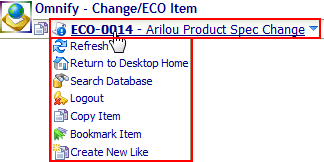
| Refresh |
Refreshes/Reloads the Change |
| Return to Desktop Home |
Redirects you to the Desktop Home Page |
| Search Database |
Redirects you to the Database Search form |
| Logout |
Logs you out of Desktop |
| Copy Item |
Places the item in the system buffer |
| Bookmark Item |
Bookmarks the form |
| Create New Like |
Invokes the New Like form |
The top right section of the banner contains the following hyperlinks:

| Refresh |
Refreshes/Reloads the Change |
| Home Page |
Redirects you to the Desktop Home Page |
|
 |
Data Page Navigator |
Top |
|
The Data Page Navigator allows you to quickly jump to the different data sections of the Change.
Selecting an option from the list will update the data page pane to display that data section.

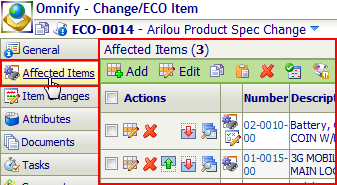
The Navigator page names can be modified using XML Dictionary files.
Contact a qualified Omnify Application Engineer for more information on creating XML Dictionary files.
|
|
|
All Changes/ECOs contain the following data pages:
| General |
Change Number, Type, Priority, Reason, Description |
| Affected Items |
Items/Parts/BOMs affected by the change, revision options, material dispositions |
| Item Changes |
Changes/Actions to perform to the affected items |
| Attributes |
Use parameters to define additional change information |
| Documents |
Document links for ECO (Rework instructions, Markup drawings, etc.) |
| Tasks |
Tasks assigned to resources |
| Comments |
General user and signoff comments |
| Associations |
Associated Changes and CAPA objects |
| History |
List of changes that have occurred to the Change/ECO (User, Date, Tool Used) |
| Signoff |
Users who are reviewing or are required to sign-off on this item |
| Training |
Associated training items |
|
 |
Releasing Changes |
Top |
|
Once all required users have approved the Change/ECO it will then be available for release.
To release a Change, select the General page.

In the Status Area click the Change Status hyperlink.
This will display the Change Status dialog box.

Set the Update Status drop list to Released.

Click the Release Change button.

A confirmation page will appear that will display the affected items.
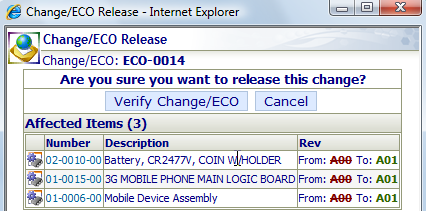
To start the release process, click the Verify Change/ECO button.

The Change/ECO verifier will execute various checks (Tasks, Status, Revisions, required fields, etc.).
If any issues were found, the system will not allow you to release the Change/ECO.
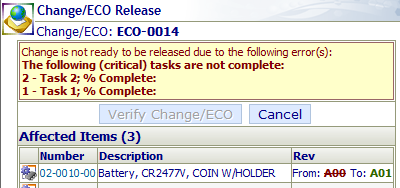
If the verification was successful, the results will be displayed and a Release Change button will appear.
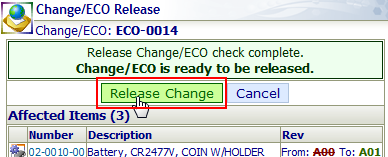
Click the Release Change button to have the system release the Change/ECO and perform all revision changes and associated item changes/redlines.
|